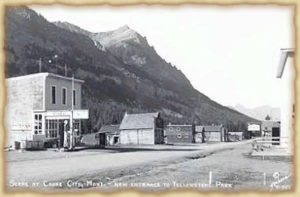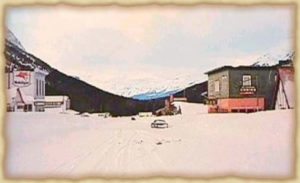History of the Cooke City Store
Marking its 100th year of general merchandising, on March 27, 1986, the Cooke City Store was listed in the National Register of Historic Places. The property was judged to be worthy of preservation because it retains excellent historic architectural integrity and is highly unusual as an intact, historically appearing and functioning small town mercantile store.
The ground on which the Cooke City Store was built was originally part of the "Cache of Ore Millsite," owned by George A. Huston, the earliest known prospector in the region. By the spring of 1886, John Savage and John Elder had purchased the site and were hauling milled lumber from the lower elevations around Cooke City to begin construction of their store. By the late 1880's Savage and Elder's was providing supplies for the community and area miners, but also had competition from Bause and French's mercantile store.
During the late 1880's the population in Cooke City varied from as many as 1,000 to as few as twenty people. By the summer of 1889, Savage and Elder had sold their store to William Nichols and Hiram Chittenden for $800. Nichols and Chittenden paid an additional $250 to Joe Keeney to prevent the estate and heirs of George Huston from claiming any ownership of the old millsite. After overextending themselves to their wholesalers, Nichols and Chittenden relinquished the store in 1893 to George L. Carey for creditors in trust. A few days later the property was transferred to the Livingston National Bank by court order, which stipulated that William Bause be the receiver of "all property of the firm of Nichols & Chittenden, including the stock of general merchandise contained in Nichols and Chittenden's store building, as well as about 30 cords of wood standing on the adjoining west lot."
Cooke City experienced slow growth in the early 1890's and in the summer of 1893 when the national mining economy suffered a major depression the store began to be used exclusively for storage. On November 14, 1895, the court authorized the sale of the store to Sophia Wetzstein for $600. She and her husband owned other property in Cooke City and were involved in the wholesale liquor business in Livingston. A boost in mining operations in 1905 occasioned by the introduction of more efficient means of ore processing improved the local economy, and several mining companies reopened their properties. One of these firms, the Cooke City Smelter, which began operating under the direction of George Allison, leased the Wetzstein's Cooke City Store in 1906 for $300 a year for use as a general store. Allison began an extensive remodeling of the building , and in the spring and summer of 1907, the renamed Cooke City Smelter was enlarged and sided with decorative pressed metal. Allison operated the store for two years but his ambition proved too great for the company’s resources, and by the summer of 1908 the Cooke City Smelter was in serious financial difficulty. The store began selling goods at cost and for cash only, and when Allison's lease expired in July of 1908, Nels and Elizabeth Soderholm bought the store for $3,000 with $500 as a down payment, and $500 per year for five years at six percent interest. After relinquishing the property, Allison began constructing a new store, financed from the sheriffs sale of the Cooke City Smelter, directly across the street from the Cooke City Store. By the fall of 1908 the Allison Mercantile Company had opened with furnishing and fixtures from the Cooke City Store which Allison had removed for his new building.
In January, 1909, Nels became postmaster for Cooke City. In the winter, mail was brought by another postal employee from Nye (40 miles north) on skis to a cabin near Lake Abundance where Soderholm had skied Daisy Pass to deliver and retrieve the mail. The money earned by the Soderholms from the postal work enabled them to remodel the front room of the second story in their store into an apartment. While the Cooke City Store added new lines to its expanding inventory and continued to prosper, early in 1911 the Allison Mercantile Company went bankrupt. Many of the fixtures that had originally been put into the Cooke City Store when Allison had occupied it were then sold to Soderholm at a sheriff's sale and placed back in the store. In anticipation of the auto tourist industry, Nels Soderholm purchased a bulk fuel tank and hauled gasoline to a Conoco station which he operated adjacent to the store. The interior of the building was modernized by the replacement of the original gas lighting system with two Kohler diesel light plants, and by the addition of a water storage locker and septic tank.
In the summer of 1938, the Soderholm's nephew Sam Brady came to work at the store. Sam had lived with his family on an early-day Montana homestead in the Shields Valley. Nels Soderholm died in 1939, and Sam helped his Aunt Lizzy off and on during the busy summer seasons for the next decade, deciding to work at the store on a year-round basis in 1949. When Mrs. Soderholm's eyesight and general health forced her to retreat to the low-country, Sam took over full operation of the store in October of 1957. The early years were lean and hard. Winter heating needs required the carrying of coal from the basement to the main floor and upstairs, and on particularly cold nights the pipes would freeze and break. After several years of waging this battle, Sam installed a new, low ceiling and an oil furnace in the winter of 1963. As electric coolers and freezers revolutionized the grocery business, these modern conveniences were added, requiring the removal of some of the oak shelving.
Sam often said that his single operation of the store would not have been possible without the help of his sister Betty Bischoff. Betty's career with the Red Cross allowed her the freedom to spend the summer months helping Sam at the store. Betty's wide travels introduced her to many varied cultures, and each year she brought back stories and unusual goods to be shared in the store. In the summer of 1978, Betty died after a long illness; she is missed in a very special way by her many friends and patrons of the store.
In November of 1974, Ralph and Sue Glidden moved to Cooke City from Oregon to spend a winter cross-country skiing and visiting Sue's mother, Mrs. Jean Higham. Sue's family had owned a sheep ranch in the Clarks Fork Valley, and the operation had included summer grazing high in the rugged alpine tundra of the Beartooths. In June of 1975, Ralph began work as a clerk at the Cooke City Store. Sue began work in the summer of 1976, and the two continued as employees until they bought the store in January of 1977.
During the summer of 1984 at age 14, Troy Wilson began working at the Cooke City Store. He continued to work at the store for the next ten summers. In the summer of 1988 he met his future wife, Bethany Gould, who was working at an area ranch. Beth worked her first summer at the store in 1990. Troy and Beth married in 1992 and worked at the store for two more seasons. As Ralph and Sue prepared for retirement, they approached the Wilsons about buying the store. Troy and Beth spent the summer of 2003 reacquainting themselves with store operations, and then fulfilled their dreams by purchasing the Cooke City Store in October 2003.
Since its construction in 1886 when it provided miners and settlers with a wide range of merchandise, the Cooke City Store has continuously served area residents and tourists as a major source of supplies and goods in this remote area.







